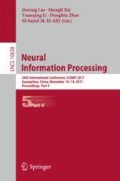Abstract
Forecasting events like crimes and terrorist activities is a vital important and challenging problem. Researches in recent years focused on qualitative forecasting of a single type event, such as protests or gun crimes. However, events like crimes usually have complicated correlations with each other, and a single type event forecasting cannot meet actual demands. In reality, a quantitative forecasting is more practical for policy making, decision making and police resources allocating. In this paper, we propose an interweaved time series and an interpretative locally connected Recurrent Neural Network model, which forecasts not only whether an event would happen but also how many it would be by each type. Using open source data from Crimes in Chicago provided by Chicago Police Department, we demonstrate our approach more accurately in forecasting the crime events than the existing methods.
References
Bollerslevb, T.: Generalized autoregressive conditional heteroskedasticity. J. Econom. 31(3), 307–327 (1986)
Chen, Y., Yang, J., Qian, J.: Recurrent neural network for facial landmark detection. Neurocomputing 219(2017), 26–38 (2017)
Cho, K., van Merrienboer, B., Gulcehre, C., Bahdanau, D., Bougares, F., Schwenk, H., Bengio, Y.: Learning phrase representations using RNN encoder-decoder for statistical machine translation. In: Proceedings of the 2014 Conference on Empirical Methods in Natural Language Processing (EMNLP), pp. 1724–1734. Association for Computational Linguistics (2014)
Hochreiter, S., Schmidhuber, J.: Long short-term memory. Neural Comput. 9(8), 1735–1780 (1997)
Hong, Q., Manrique, P., Johnson, D., Restrepo, E., Johnson, N.F.: Open source data reveals connection between online and on-street protest activity. EPJ Data Sci. 5(1), 1–12 (2016)
Kieltyka, J., Kucybala, K., Crandall, M.: Ecologic factors relating to firearm injuries and gun violence in Chicago. J. Forensic Leg. Med. 37(2016), 87–90 (2016)
Mohler, G.: Marked point process hotspot maps for homicide and gun crime prediction in Chicago. Int. J. Forecast. 30, 491–497 (2014)
Ning, Y., Muthiah, S., Rangwala, H., Ramakrishnan, N.: Modeling precursors for event forecasting via nested multi-instance learning. In: Proceedings of the 22nd ACM SIGKDD International Conference on Knowledge Discovery and Data Mining, pp. 1095–1104. ACM (2016)
Smith, C.M., Papachristos, A.V.: Trust thy crooked neighbor: multiplexity in Chicago organized crime networks. Am. Sociol. Rev. 81(4), 1–24 (2016)
Sutskever, I., Vinyals, O., Le, Q.V.: Sequence to sequence learning with neural networks. In: Advances in Neural Information Processing Systems, vol. 4, pp. 3104–3112 (2014)
Tang, Y., Huang, Y., Wu, Z., Meng, H., Xu, M., Cai, L.: Question detection from acoustic features using recurrent neural network with gated recurrent unit. In: IEEE International Conference on Acoustics, Speech and Signal Processing, pp. 6125–6129 (2016)
Williams, R.J., Zipser, D.: A learning algorithm for continually running fully recurrent neural networks. Neural Comput. 1(2), 270–280 (1998)
Zhao, L., Sun, Q., Ye, J., Chen, F., Lu, C.T., Ramakrishnan, N.: Multi-task learning for spatio-temporal event forecasting. In: ACM SIGKDD International Conference on Knowledge Discovery and Data Mining, pp. 1503–1512 (2015)
Zhao, Y., Zou, X., Xu, H.: Improving forecasts of generalized autoregressive conditional heteroskedasticity with wavelet transform. Res. J. Appl. Sci. Eng. Technol. 5(2), 649–653 (2013)
Zhu, W., Lan, C., Xing, J., Zeng, W., Li, Y., Shen, L., Xie, X.: Co-occurrence feature learning for skeleton based action recognition using regularized deep LSTM networks. In: The AAAI Conference on Artificial Intelligence, pp. 3697–3703 (2016)
Acknowledgements
This research has been supported by National Natural Science Foundation of China (No. 61572514) and (No. 61170285).
Author information
Authors and Affiliations
Corresponding author
Editor information
Editors and Affiliations
Rights and permissions
Copyright information
© 2017 Springer International Publishing AG
About this paper
Cite this paper
Wang, K., Zhu, P., Zhu, H., Cui, P., Zhang, Z. (2017). An Interweaved Time Series Locally Connected Recurrent Neural Network Model on Crime Forecasting. In: Liu, D., Xie, S., Li, Y., Zhao, D., El-Alfy, ES. (eds) Neural Information Processing. ICONIP 2017. Lecture Notes in Computer Science(), vol 10638. Springer, Cham. https://doi.org/10.1007/978-3-319-70139-4_47
Download citation
DOI: https://doi.org/10.1007/978-3-319-70139-4_47
Published:
Publisher Name: Springer, Cham
Print ISBN: 978-3-319-70138-7
Online ISBN: 978-3-319-70139-4
eBook Packages: Computer ScienceComputer Science (R0)

